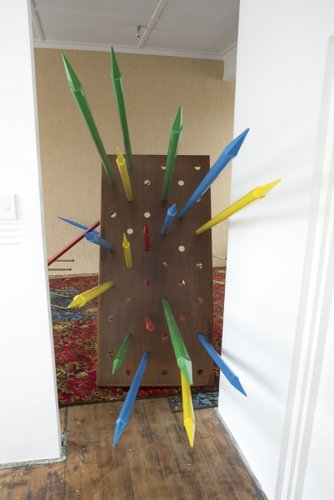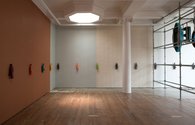John Hurrell – 8 December, 2015
Just before you reach the landing, there appears to be a cluster of parallel spears protruding through the doorway, like lances from Athenian warriors in the Peloponnesian War. They are held up in a ‘defensive' position by being threaded through a leaning school table that doubles as a shield. If you squeeze past them and enter Lett's library you can see more wallpaper and several garish Axminster rugs on the floor with floral arabesques and hot colours…
In this clever two-part installation (upstairs library and downstairs gallery) we see a Michael Parekowhai project that conceptually connects up a number of works he has presented on earlier occasions in other spaces. The title references a satirical Jean Renoir film (1939) famous for its matter-of -fact (ie. brutal) rabbit hunt, a section which Parekowhai presents on video as a sort of ‘revenge of the colonised’ - tied in with his earlier stuffed rabbits, sparrows and inflatable McMurtrie as signifiers for rapidly breeding invaders. The neon sign saying ‘Closed’, displayed high up on scaffolding so it lights up East Street at night, can mean closed gallery (don’t come in), closed country, closed society (in wealth distribution) or closed minds.
The gallery section involves a high wall of scaffolding, the elaborately decorative sign (in the multi-font style of Jack Pierson), three large sections of comparatively tasteful wallpaper and 21 fibreglass sculptures of ‘Magritte men’: each commuter with bowler hat, brolly and briefcase. Nine are brightly coloured, a dozen ‘dreamers’ are in grey; some are facing out, the rest are turned into the wall (ignoring the world and its suffering: there’s a clear political dimension).
Upstairs the mood is even more confrontational. Just before you reach the landing, there appears to be a cluster of parallel spears protruding through the doorway, like lances from Athenian warriors in the Peloponnesian War. They are held up in a ‘defensive’ position by being threaded through a leaning school table that doubles as a shield. If you squeeze past them and enter Lett’s library you can see more wallpaper (a symbol for ‘covering over’ perhaps?) and several garish Axminster rugs on the floor with floral arabesques and hot colours. Positioned on them are four school chairs, remade with brass legs and oak backs, again (like the desk) impaled by aluminium pick-up sticks / spears. Seemingly a comment on the nation’s education (and social mobility) system.
So the show’s heading - Renoir’s title? What’s that about in Parekowhai’s context? The rules of the art (sales /academic credibility) game; the social hierarchy (maybe not Māori versus Pakeha, but within Māori, within Pakeha) game; the pick-up sticks (acquiring assets) game?
I think this is a really intriguing, poetical, exhibition, maybe the best show Parekowhai has done. I like its physical and conceptual layering, its deft use of appropriated language, and the growing sense of cohesion that slowly dawns on you, especially when referencing similar works that have been shown before. There’s a peculiar symmetry of violence with the tilted spears in the besieged place of learning above, and Renoir’s upper middleclass hunting party (and Magritte’s vacillating bankers) below.
There is also a Duchampian smirk at visual vulgarity and elegance together, a strong sense of irony mocking both excessive ornamentation and tasteful restraint, switching the interior décor codes of erudition and commerce where one is architecturally above the other. Parekowhai is mischievous and openly slippery, unexpectedly clamping opposites tightly together, while tugging at the rug of assumptions that is positioned under your feet as soon as you step through the door.
John Hurrell







 Two Rooms presents a program of residencies and projects
Two Rooms presents a program of residencies and projects Advertising in this column
Advertising in this column



This Discussion has 0 comments.
Comment
Participate
Register to Participate.
Sign in
Sign in to an existing account.